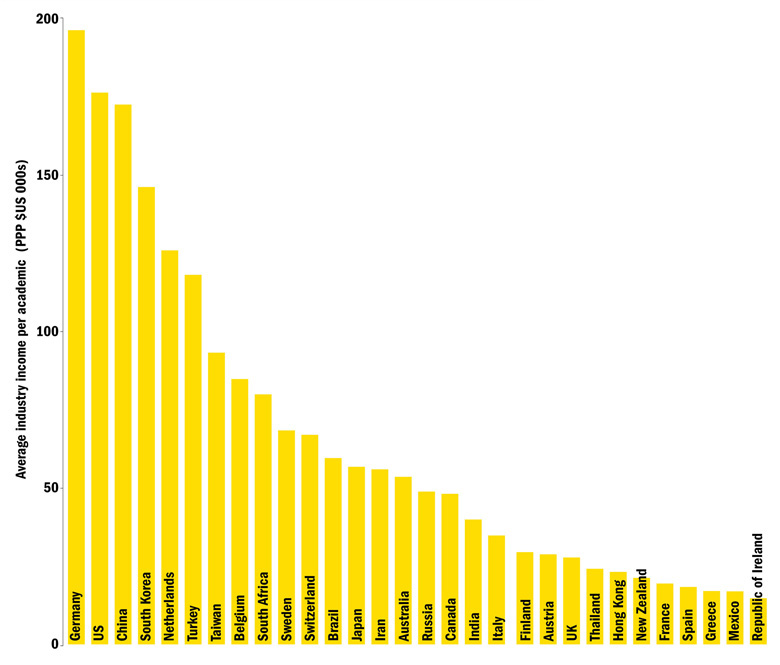Germany’s LMU Munich receives more industry funding per academic than any other institution in the world, according to Times Higher Education’s new Funding for Innovation ranking.
The university has topped a list of the world’s best 20 institutions based on their ability to secure research money from the private sector. It secured almost $400,000 (£288,500) per academic from businesses in 2013.
The US’ Duke University takes second place, with a figure of almost $290,000, while the Korea Advanced Institute of Science and Technology (KAIST) is third, with $254,700.
Europe dominates the ranking with nine institutions in the top 20, followed by Asia with seven and North America with just two. China is the most-represented nation, with four universities, led by China University of Petroleum (Beijing), which received $227,600 of industry funding per academic, in seventh. Germany, South Korea, Turkey, the Netherlands and the US have two institutions each.
When assessing a country’s overall performance on this measure, Germany is top, with its best five institutions securing an average of $195,800 of industry investment per academic. It is followed by the US ($175,900) and China ($172,100).
The UK is conspicuous by its absence in the university ranking and comes 22nd in the top 30 list of countries – below Turkey, Belgium and Brazil – receiving under $28,000 of industry funding per researcher, based on the figures for its five best-performing institutions. The result comes just a week after THE reported that a survey of more than 18,000 UK academics had found that a dwindling number of scholars were commercialising their research.
Top university attractors of industry funds
| Rank | Institution | Country | Industry income per academic (PPP $US) | WUR 2015-16 rank |
| 1 | LMU Munich | Germany | 392,800 | 29 |
| 2 | Duke University | US | 287,100 | 20 |
| 3 | Korea Advanced Institute of Science and Technology (KAIST) | South Korea | 254,700 | 148 |
| 4 | Johns Hopkins University | US | 249,900 | 11 |
| =5 | Anadolu University | Turkey | 242,500 | 601-800 |
| =5 | Wageningen University and Research Center | Netherlands | 242,500 | =47 |
| 7 | China University of Petroleum (Beijing) | China | 227,600 | 601-800 |
| 8 | Pontifical Catholic University of Rio de Janeiro (PUC-Rio) | Brazil | 204,600 | 501-600 |
| 9 | Istanbul University | Turkey | 202,000 | 601-800 |
| 10 | University of Freiburg | Germany | 201,700 | 84 |
| 11 | Peking University | China | 198,800 | 42 |
| 12 | National Cheng Kung University | Taiwan | 182,100 | 401-500 |
| 13 | Pohang University of Science and Technology | South Korea | 172,800 | 116 |
| 14 | KU Leuven | Belgium | 163,700 | 35 |
| 15 | Stellenbosch University | South Africa | 156,600 | 301-350 |
| 16 | Tianjin University | China | 152,800 | 501-600 |
| 17 | Tsinghua University | China | 150,200 | =47 |
| 18 | Delft University of Technology | Netherlands | 148,700 | =65 |
| 19 | Swedish University of Agricultural Sciences | Sweden | 144,200 | 201-250 |
| 20 | University of Basel | Switzerland | 139,000 | =101 |
Notes: Income figures adjusted for purchasing power parity. Average income for country based on mean figure from top five universities for industry income in each country.
Source: THE DataPoints © THE data@timeshighereducation.com
Gerard Postiglione, director of the Wah Ching Centre of Research on Education in China at the University of Hong Kong, said that China’s success could be attributed to its large number of state-owned enterprises, coupled with the fact that its “top-tier universities are all government funded”, while South Korea’s achievement of fourth place reflects that it is a “highly industrialised country”.
He added that the relocation of Hong Kong’s manufacturing industry to China in the 1980s could be one reason why the city “pales in comparison” in the list: it ranks 24th and there are no Hong Kong institutions in the university list.
Philip Altbach, founding director of the Center for International Higher Education at Boston College, added that US universities have strong links with industry for a number of reasons.
“First, some US universities pay a lot of attention to monetising intellectual property, and encourage their academics to think about this. Second, US universities are typically more flexible in terms of setting up interdisciplinary labs and other structures that make this kind of work possible. And third, some American academics, especially at top universities, think ‘entrepreneurially’,” he said.
The data for the THE Funding for Innovation ranking were extracted from the THE World University Rankings 2015-16. The indicator was defined as “research income from industry and commerce” and does not include public funding for universities.
Only countries with at least five universities in the THE rankings database were included, and only the top five institutions from each country were analysed. The data relate to the 2013 academic year, are presented in US dollars and are subject to purchasing power parity normalisation.
Average industry income per academic by country
What is the winning formula for innovation funding?
Johns Hopkins University, which received $250,000 of industry funding per academic in 2013, sees the majority come from pharmaceutical companies for its School of Medicine and its Bloomberg School of Public Health.
One recent research project saw the institution collaborate with MedImmune, the biologics research and development arm of AstraZeneca, on a $6.5 million initiative that looked into respiratory problems, oncology, infectious disease and antibody discoveries.
Christy Wyskiel, senior adviser to president Ronald J. Daniels and part of the Johns Hopkins Technology Ventures unit, said that there had been more interest in marketing research in the past few years – and in ensuring that these lessons were passed on to students.
“We have a business school with a course called ‘Discovery to Market’, where students learn how to bring a product to the market,” she said.
“As a university, we are very focused on student experience, and in addition to being able to work in some of the most world-renowned labs they can also contribute through internships and are exposed to entrepreneurship.”
Duke University also has a close relationship with the medical and pharmaceutical industries through its Clinical Research Institute, which has more than 1,200 employees who work mostly on large clinical trials for new drugs. The institute’s total revenue is more than $200 million, 35 per cent of which comes from federal or other institutional funding, while the rest comes from industry research streams, said its director Eric Peterson.
“I think there are two reasons we got to this position. We are leaders in this field, and industry figures seek us out now,” he said.
“But many of us also work closely with government. Our actual founder, Rob Califf, is now to be the new head of the Food and Drug Administration, for example."
Jess Staufenberg
POSTSCRIPT:
Print headline: The captains of industrial largesse
Register to continue
Why register?
- Registration is free and only takes a moment
- Once registered, you can read 3 articles a month
- Sign up for our newsletter
Subscribe
Or subscribe for unlimited access to:
- Unlimited access to news, views, insights & reviews
- Digital editions
- Digital access to THE’s university and college rankings analysis
Already registered or a current subscriber?




